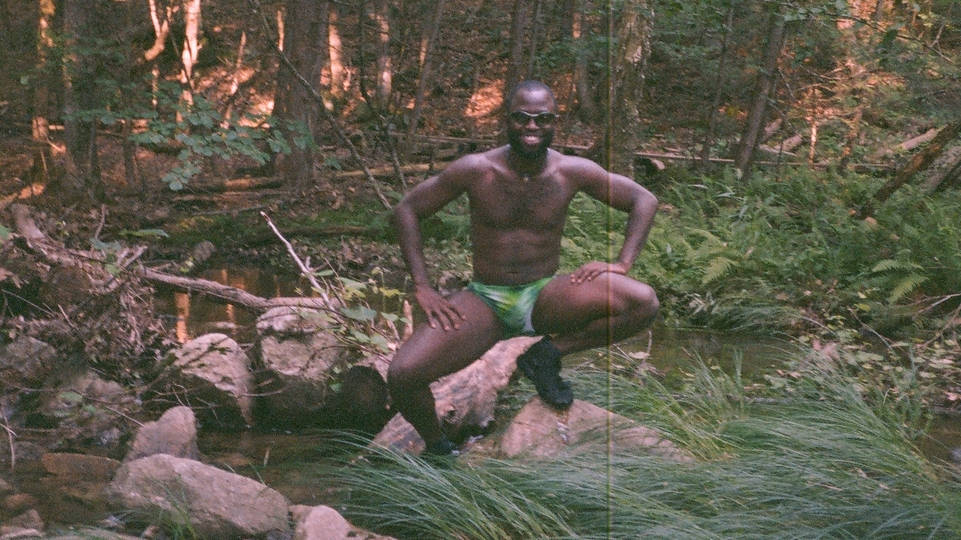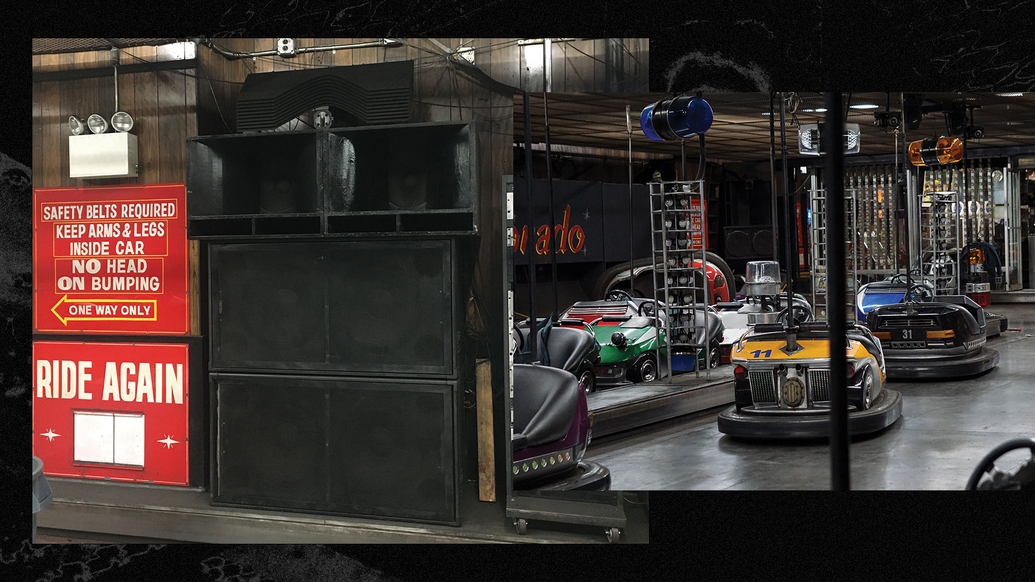
Bump up the volume: this New York bumper car soundsystem is a priceless artefact of DJ culture
An iconic 1970s soundsystem lives on inside a Coney Island attraction. Vivian Host catches up with sound engineer Dan Prosseda about the magical speaker stacks of the Eldorado Auto Skooter bumper cars
Most of New York’s revered club soundsystems of the ‘70s and ‘80s are long gone, as are many of the men who built them. Richard Long, notable for his bass innovations and the incredible physics of his handcrafted cabinets, died of AIDS in 1986; the awe-inspiring speaker cabinets and bass horns he designed for the likes of the Paradise Garage, Studio 54 and the Funhouse have been dismantled for decades. Now in his 80s, Alex Rosner — who pioneered the stereo DJ mixer and tweeter arrays at The Loft — continues to build some of the best sound arrays around, but mostly for hotels and cathedrals. Even the booming speaker stacks Steve Dash created for the Sound Factory and Twilo in the ’90s are just mythical whispers in the mouths of those old enough to remember.
And yet, there is a place you can experience what NYC’s soundsystems of yesteryear looked and sounded like — and, more importantly, what they felt like. On Surf Avenue in Coney Island, far out in Brooklyn where the F train meets the beach, next to the Coney Island Circus Sideshow and an alleyway of carnival games known as The Bowery, is one of the only remaining examples of the custom-built analog soundsystems of disco’s past, housed inside the Eldorado Auto Skooter bumper cars. Almost 40 years after it was installed, the warm thump of the Eldorado’s sound continues to rival that of New York City’s biggest clubs, thrilling obsessive audiophiles and Coney Island residents alike.
“Our sound is extremely powerful yet very easy to listen to, it doesn’t hurt the ear,” boasted Eldorado co-owner and soundsystem curator Scott Fitlin to the Amusing the Zillion blog, shortly before he passed away in 2010. “CRYSTAL CLEAR, lightning fast, and stunning transient response — the crack of the snare drum is scary. Our bass is tremendous and I play dance music, the sound that has energy and life and POSITIVITY!”
Sound engineer Dan Prosseda, 73, has presided over the Eldorado’s soundsystem for about eight years, since the attraction was saved from being dismantled in 2012. Prosseda began working at Coney Island in 1994, when he was asked to take care of sound at the Polar Express, an outdoor ‘Himalaya’ ride featuring cars attached to a circular track which go faster and faster, before reversing and going backwards.
“Ronnie [Guerrero, who owned the ride] had a really good soundsystem there which would attract pretty much the whole block full of people just to listen to the music,” he recalls, smiling. “I’m not sure how many sales he actually got out of the ride!”

“By the late ’70s, with club and bar owners starting to pour more money into their sound, and with the thump of the disco beat through restaurant and apartment walls becoming more prevalent, speaker installation and soundproofing were starting to become a big business”
Prosseda grew up about 20 minutes from Coney Island, in the largely Italian-American neighbourhood of Dyker Heights, Brooklyn. His first taste of the music business came in 1964, when his psychedelic garage band Head Shop signed to Epic Records. The group released a popular debut album and hit the charts in 1969, but their producer / manager made off with their advance money to pay for his brain-tumor surgery and they were dropped from their record deal.
Head Shop, and their second incarnation called Household Sponge, ultimately disbanded around 1971 — which, as it turned out, this was perfect timing. DJ culture and the disco era was just about to explode in New York City, and Dan’s friend and former bandmate Joe Siano was about to become a fixture on the scene, thanks to the vision of his younger brother, the influential New York DJ Nicky Siano. Inspired by visiting David Mancuso’s Loft — where former defense engineer Alex Rosner was pioneering modern-day club sound with his custom tweeter arrays and specialty speaker arrangements — Nicky and Joe teamed up in early 1973 to open an underground nightspot called The Gallery, in a disused warehouse on West 22nd Street in Chelsea.
An antidote to the glitzy, often Mafia-backed straight clubs of the era, renegade clubs like The Loft and The Gallery, later followed up by Nicky’s friends Larry Levan at the Paradise Garage and Frankie Knuckles at Chicago’s Warehouse, allowed DJs and engineers to experiment with different speaker placements, custom-built sound and lighting components, and music blends and turntable tricks — the lessons learned from this era ultimately form the foundation for nightclubbing and DJing as we know it today.
“Joe [Siano] went to engineering school, and had become a professional engineer,” says Prosseda. “He called me over one night to The Gallery to listen to the soundsystem. He had it professionally done by Alex Rosner; at the time, there were only two or three installers that did that. I went ‘Wow, this is really nice’. We got to talking and between both of our experience we thought, ‘Hey, we could do this.’”
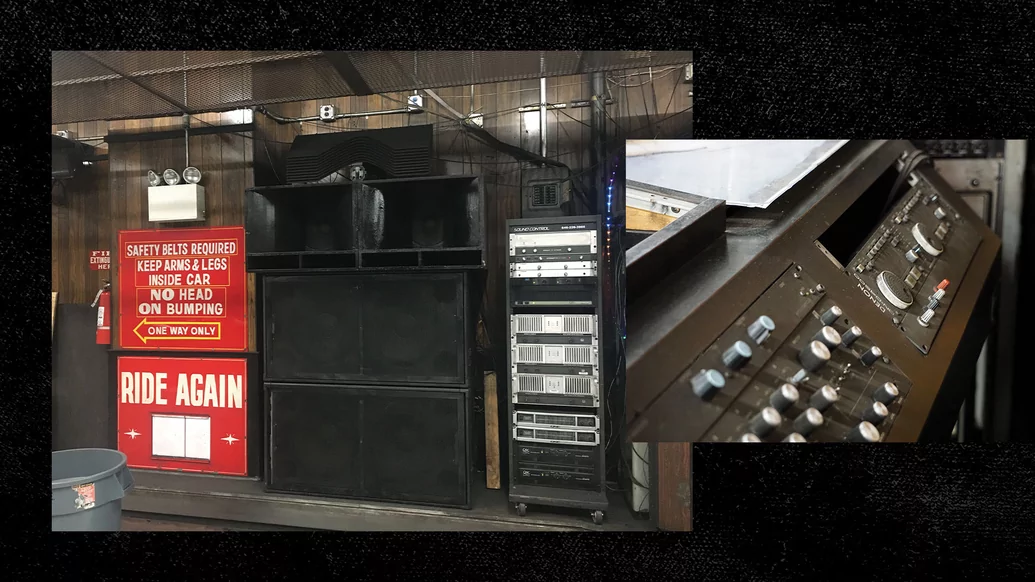
By the late ’70s, with club and bar owners starting to pour more money into their sound, and with the thump of the disco beat through restaurant and apartment walls becoming more prevalent, speaker installation and soundproofing were starting to become a big business. Through Joe and Dan’s connections, new work was easy to find. “It was all intertwined. Nicky would be working the nightclubs, and when something would break he would call Joe and we would be able to go right down there and fix it.”
Perhaps not coincidentally, the Eldorado Auto Skooter also opened its doors in 1973. On 21st March, it debuted with a soundsystem that would go on to be one of the best in New York City — thanks to Scott Fitlin, who was obsessed with high fidelity, DJing and the new dance music sounds of the day.
“The owner Sandy Fitlin (Scott’s dad) and his uncle Peter Buxbaum put together the soundsystem at first, and most of the original speakers are still here,” Prosseda says. “Scott, who in my opinion had a ‘golden ear’, tinkered with it as he grew up; he got parts to enhance it and turned it into a more famous-type soundsystem.”
Scott Fitlin had been bitten by the power of amplified sound early on. His family owned the Eldorado Arcade, so he grew up with the amusement park as his playground. “Back in 1969, I would be in my family’s place, and they would let me go out in the evening by myself to go on some rides,” Fitlin wrote on a Coney Island message board. “My dad would always tell me to stay off of West 12th Street. The Twins’ Himalaya, [a precursor to the Polar Express], had the best sound and music at that time — a HUGE crowd dancing in front of the ride.
“That’s where my dad would always come find me, hanging out dancing to Stax and Motown [records]! They would call out my name over the speakers from the DJ booth, and I would go up on the ride to the booth. Big Willie was the DJ, and he would show me how the ride ran and how the music was played. Then he would put me on the mic to scream out ‘Himalayaaaaaaa, Owwwwwwwwww!’ To a young boy, looking out at the street with what seemed to be thousands of people boogieing, that was the entire world for me right there!”

At the Eldorado bumper cars, Fitlin got to take charge of his own soundsystem, DJ setup and Studio 54-style lighting rig. Part of Scott’s enhancement efforts involved calling in the near-mythical Richard Long, who was famous for designing the sound at Studio 54 and the Paradise Garage. Long’s signature bass cabinets and custom-built crossover (the filter which divides a full-range audio signal into highs, mids and lows that it sends to the appropriate speakers) are still key components of the Eldorado system 40 years later, having survived decades of bumper-car reverberations — and Hurricane Sandy, which left the speaker stacks floating in over six feet of water.
“Scott and I became friends while I was servicing sound at the Polar Express, which is now an empty lot,” says Prosseda, walking around the bumper car ring on a blustery off-season day. “That also had a pretty famous soundsystem, which was put together by the owner of that establishment,” he says. “The horns were old Altec Voice of the Theatre horns, which were very common in the early ’70s. Manufacturers didn’t really have all-in-one systems you could buy back then; we used to have to design and build our own, especially for the emerging disco industry.
“That’s how Richard Long got his reputation — he designed and made his own cabinets because there wasn’t anything available off the shelf,” he adds “His electronics were state of the art. His most famous innovation was the bass horns; he used to hand-build them. A small bass horn would be called an Emerald and a double one in the same cabinet was called a Bertha. It was all done with correct physics. He would make extensions to the Bertha which would couple the soundwave to the air and make it more efficient but also make it throw a lot farther, so you get that chest-pounding [from the bass].”
“To get such low frequencies, you need a gradual extension of the [sound]wave,” Prosseda continues, gesturing at the relatively low-profile black speaker cabinets taking up one wall of the venue. These are Long’s elusive bass cabinets known as the J-horn. Originally designed for the roller rink at The Roxy, they have a distinctive, meticulously shaped scoop at the bottom (similar to a ski jump, or the letter J) that creates body-quaking bass, making you understand why the Eldorado Auto Skooter’s slogan is “Bump Your Ass Off”.
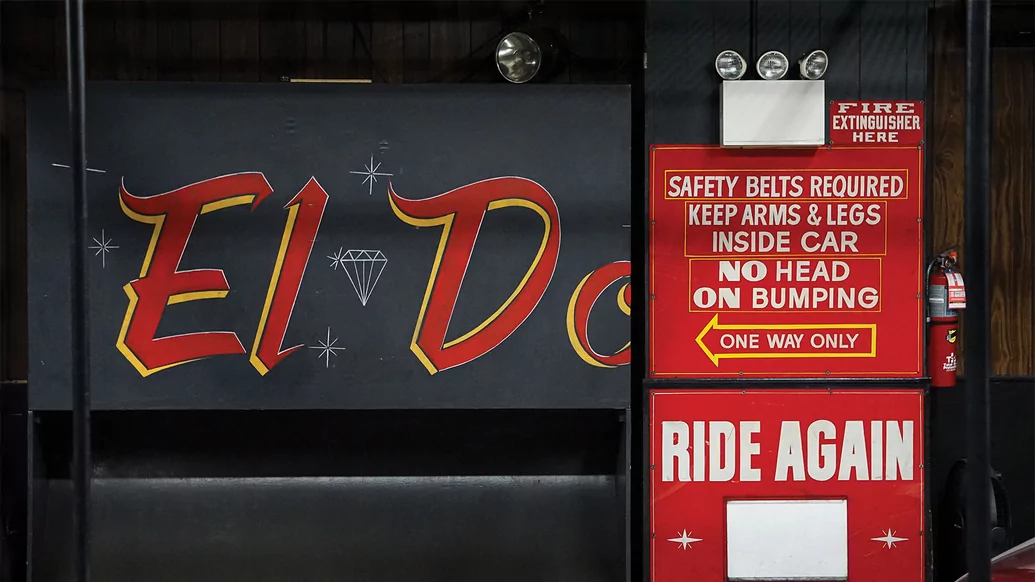
“Coney Island rides and roller rinks have a special place in the heart of several decades of New Yorkers as the first places they were exposed to DJs and DJ culture. And for years, the Eldorado DJs have had access to something unique to any DJ booth in NYC — a Richard Long crossover.”
“Richard didn’t want the speakers taking up the whole floor of the space,” Prosseda explains. “The only way you could make these cabinets a manageable size would be to fold the sound in on itself. Sound comes in one way and then it hits a wall; it bends back and hits another reflector and goes out, with [each reflection] successfully widening the bass.”
But bass isn’t everything — on top of the Eldorado speaker stacks are so-called slant plates, which look like the grills on an air conditioner. “That’s the high frequency horn or the mid-frequency horn,” Prosseda says. “They disperse the sound around the room rather than shoot it out.”
A quick look around the top of the room reveals several other features you’d probably never noticed while you’re busy viciously bumping the back of your friend’s buggy: proper heavy-duty fibreglass acoustical treatment in the ceiling (“So it doesn’t sound really cavernous in here”) and original Alex Rosner tweeter arrays, the kind that helped captivate Siano at The Loft those many years ago.
“Originally, a soundsystem was only supposed to be over the dancefloor to envelop the dancers,” Prosseda offers. “Tweeter arrays were used as an effect for people at the bar to keep time with the music; an enhancement to get your drinks and come back to the dancefloor. It’s all psychological.”
The tweeter arrays — a series of circularly arranged horns that amplify higher frequencies — are placed close to the ceiling, which keeps their frequencies from being ear crushing; they’re aimed high over the head of dancers (or bumper car patrons) and make the melody of a track recognisable all the way to the back of the Eldorado arcade.
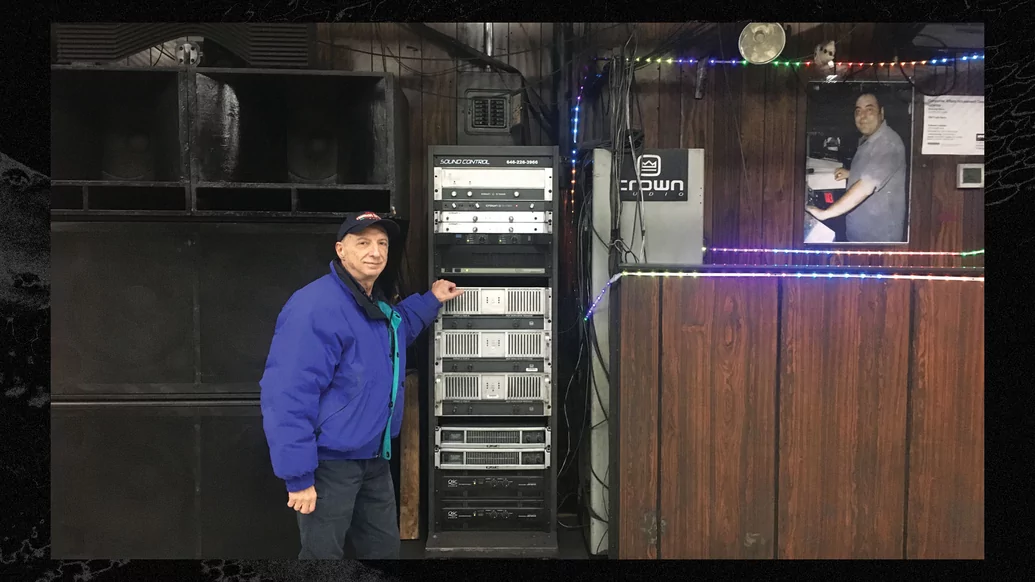
Prosseda takes me to the DJ booth, watched over by a giant smiling photo of Scott Fitlin. Whereas most amusement park and carnival rides rely on preprogrammed pop music or canned sounds, the Eldorado Auto Skooter has had live DJs continuously since they opened, although these days they’re more likely to be dropping Rihanna or the latest reggaeton cut than Donna Summer or MFSB. Coney Island rides and roller rinks have a special place in the heart of several decades of New Yorkers as the first places they were exposed to DJs and DJ culture. And for years, the Eldorado DJs have had access to something unique to any DJ booth in NYC — a Richard Long crossover.
Prior to the evolution of DJ mixers with elaborate effects and frequency controls, DJs were pressing soundsystem designers for new ways to modify the sound — the crossover was one of these inventions. “At The Gallery, Alex Rosner made it possible to isolate the bass and the tweeters, but he did it with separate components,” Prosseda explains. “He had a volume controller on a box; you’d plug that in and then feed it to the amplifier.
Richard Long took it a step further and had a rack unit built specifically for that purpose, made by Alan Fierstein at Acoustilog. Instead of having separate controls, he put it all on one unit. The idea is that you have one knob for your full-range system (which would be this whole cabinet), another knob just for the tweeters and one just for the sub-bass. You can manipulate those just for the dancefloor, and that’s how you can play the crowd. Depending on the song you might bring up the bass in a certain point of the song to get the people going or transition to another song just using the tweeters.” Prosseda demonstrates how this works to the strains of Lil Nas X’s rap-country crossover hit “Old Town Road” — not as ideal as “Love is the Message,” yet the speakers still make the track glow and thump harder than it normally does.
Prosseda’s work these days is a far cry from the mid-’90s, when he was re-coning blown speakers every weekend and piecing together custom soundsystems. These days, his Sound Control company mostly responds to noise complaint calls — outfitting businesses and apartment buildings with custom batting to prevent irritated neighbours from filing legal action. But as it gets more impossible to make noise — even in the City that Never Sleeps — it looks like the Eldorado will live to bump your ass off at least a few seasons longer.






